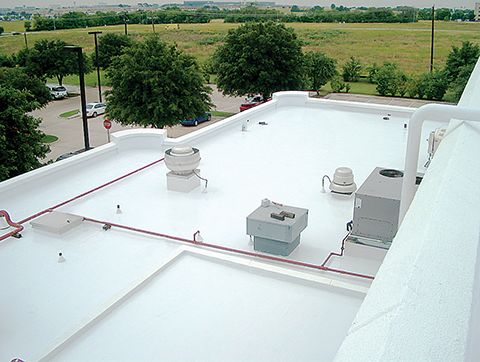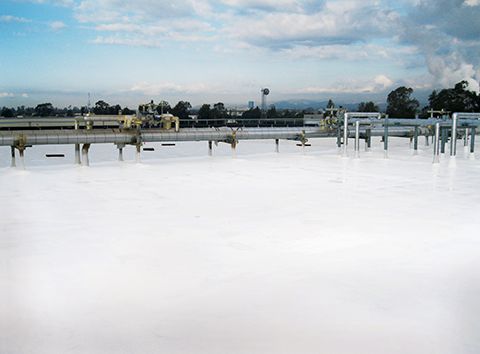Selecting and specifying roof coatings

Primers for asphalt roofs
Asphalt roofs, such as smooth-surfaced BUR or mod-bit membranes, and granulated cap sheet, contain light oils called exudate, which can leave a membrane soon after its application. This process, called, ‘tobacco juicing,’ is normal and the exudate will generally wash off the roof after rainstorms. Any exudate on a roof prior to coating application should be thoroughly removed by cleaning. Special primers, called bleed-blocking primers, are designed to resist the exudate from bleeding through to the fresh coating and may be required before the application of light-colored elastomeric coatings.
Glaze-coated built-up roofs can also release exudate. In addition, the glaze coat, if not reinforced, will crack or ‘alligator.’ One method to reduce this effect on new roofs, or to cover existing cracks in the glaze-coat of older roofs, is to prepare the roof with a layer of fiber-reinforced asphalt emulsion coating before the application of a reflective or protective coating. On old, weathered asphalt roofs, many coating manufacturers recommend use of an asphalt primer after cleaning the membrane to prepare the surface for coating.
Primers for metal roofs
A number of different types of factory-finished, metal roof panels are available. These include galvanized, fluoropolymer-based (PVDF) and siliconized polyester-based prefinished aluminum and steel, and granule-surfaced metal shingles. Depending on the factory-finish of the metal panel and the weathered condition of the panel, a primer may or may not be required before coating.
Primers are generally recommended before applying a coating to a galvanized metal assembly, regardless of whether the roof is new or old. Special primers are made for both aluminum asphalt and elastomeric coating applications over galvanized metal roof panels. Certain rust-inhibitive primers, such as zinc-chromate-based primers, may be incompatible with some coatings. Therefore, guidance from the coating manufacturer should be sought.
As previously mentioned, the use of primer is not a substitute for proper surface preparation. Rusted metal roofs can be coated after the rust conditions have been addressed. If the metal roof includes white rust (i.e. on zinc or aluminum), it can be coated after cleaning. If the metal roof includes red rust, it must be removed or treated with a corrosion-inhibiting primer. All corroded fasteners should similarily be treated or replaced.
Primers for sprayed polyurethane foam roofs
SPF roofing is coated immediately after installation to protect the material from UV degradation. Therefore, primers are not generally required in this application. However, existing SPF roofs may be coated with silicone or acrylic coatings. Sticking to silicone is difficult, so performing adhesion tests on a sample of the existing roof coating or membrane before recommending the appropriate primer is useful to help ensure the proper attachment of the new coating.

Primers for single-ply roofs
A variety of single-ply roof membranes are used in the industry, including ethylene propylene diene monomer (EPDM), polyvinyl chloride (PVC), and thermoplastic polyolefin (TPO). Each of these membranes exhibit unique coating challenges, so membrane-specific primers or primer and washes may be required before coating.
Primers for previously coated roofs
Recoating over existing coatings is a key benefit when using field-applied membranes as it leads directly to reducing the life cycle costs of a roofing assembly. Coatings have a finite service life, meaning recoating will be necessary after the existing coating has weathered and is no longer providing useful protection to the surface. Depending on the type of existing coating and the extent of weathering, it may be necessary to prime the surface before applying a fresh application of roof coating.
When coating an existing aluminum-coated roof with a water-based coating (including acrylics), priming may be necessary, because the chemical treatment used on the aluminum pigment can interfere with adhesion. Therefore,
a test application should be performed and evaluated prior to coating an existing aluminum-coated roof.
On roofs with an existing layer of acrylic coating, primer may be required before application of the new coating. The use of primer, as well as the type of product selected, will be largely dictated by the age and condition of the existing acrylic coating.
In general, only silicone-based primers and coatings should be used over existing silicone coatings because adhesion to silicone is difficult. Whether a primer is required before recoating will depend on the condition of the existing silicone-based coating.




